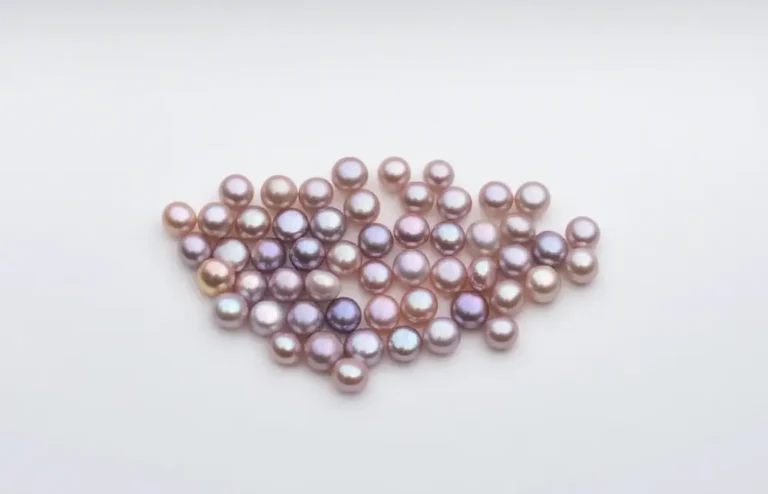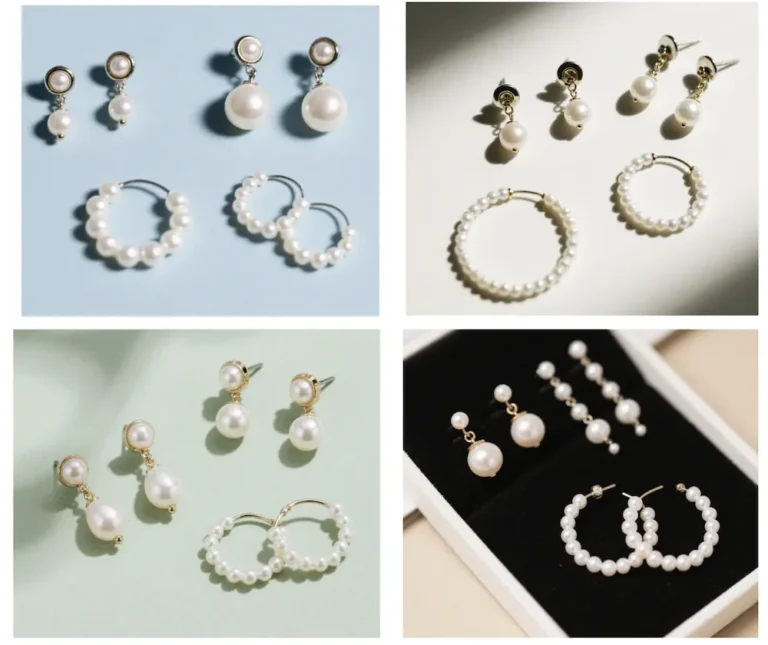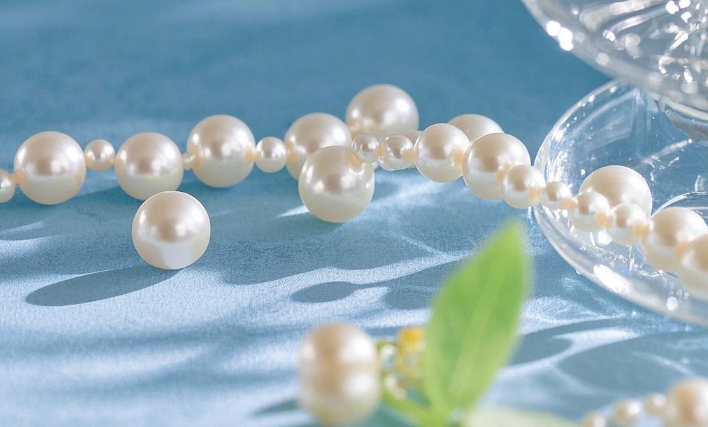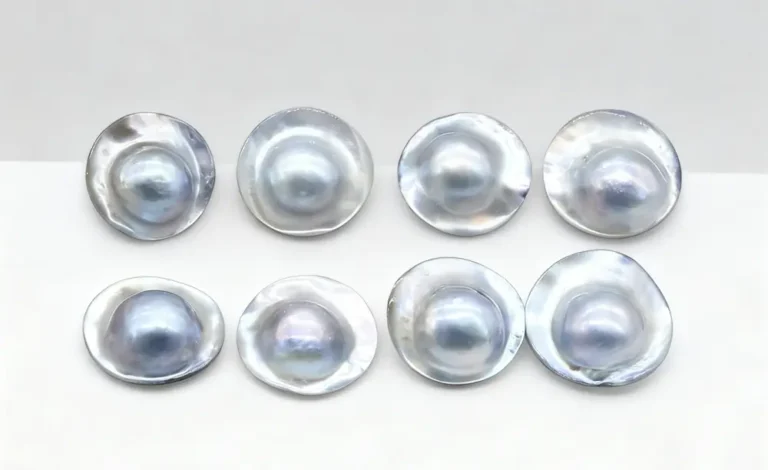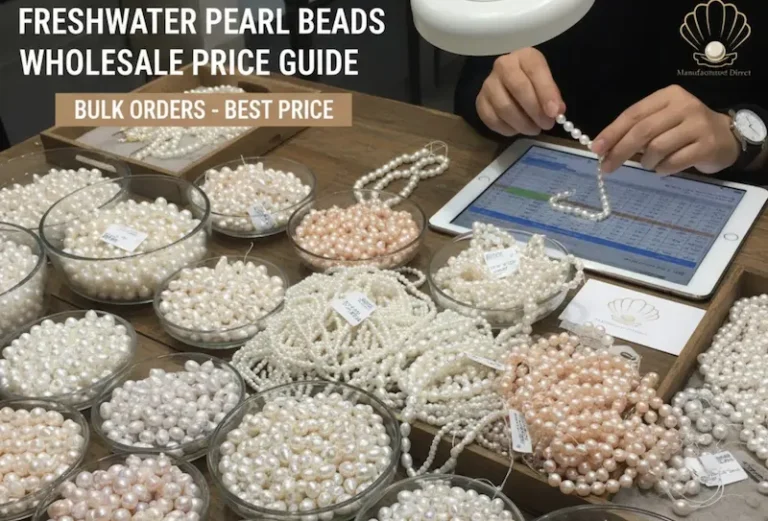When shopping for pearl jewelry, you’ll encounter terms like “freshwater pearls” and “cultured pearls” everywhere. But here’s what confuses most people about pearls freshwater vs cultured: these aren’t opposing categories at all.
Let me clear things up right now. Freshwater refers to the bodies of water where pearls thrive, such as lakes, rivers, and ponds. Cultured explains how it is created—through human interaction. Most pearls seen today come into both categories: farmed freshwater pearls.
Understanding the relationship between pearls freshwater vs cultured varieties transforms you from a confused shopper into an informed buyer. Let’s break down exactly what you need to know.
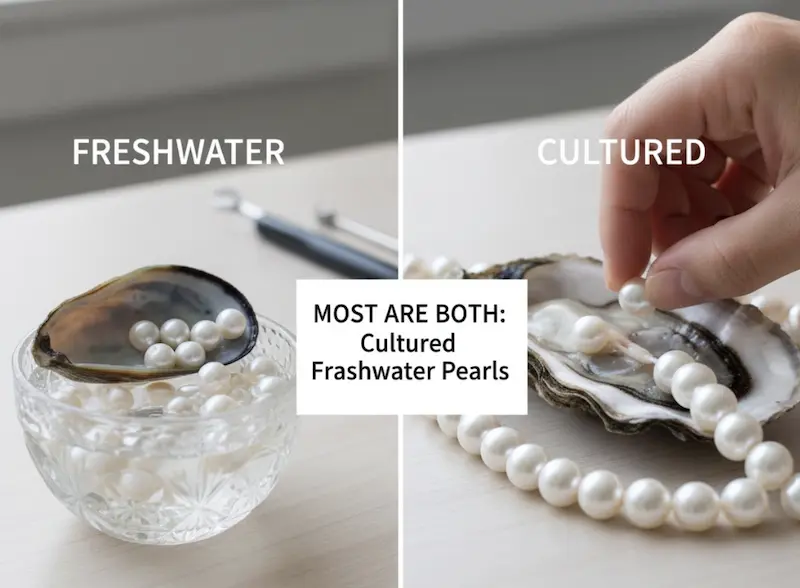
1. The Two Main Pearl Categories You Must Understand
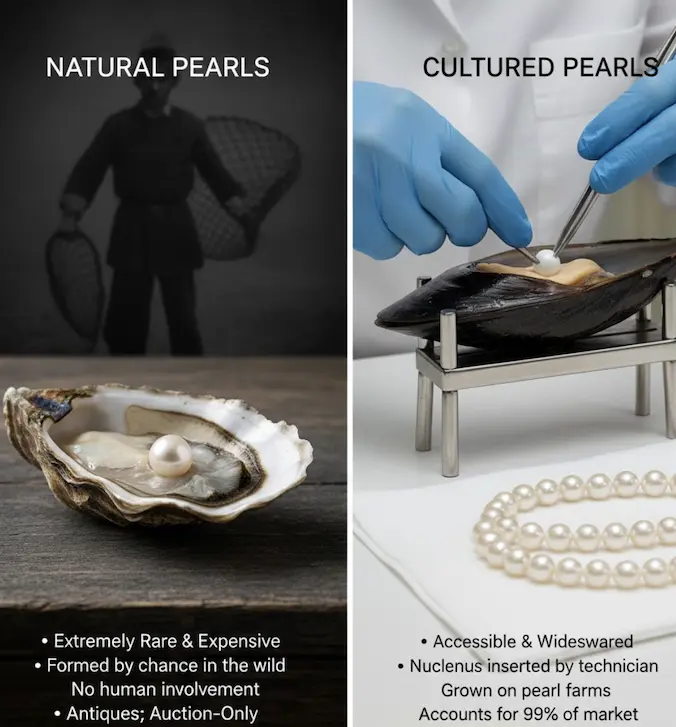
Natural Pearls: Nature’s Rare Accidents
Natural pearls form completely by chance in the wild, with zero human involvement. An irritant—perhaps a parasite or grain of sand—accidentally enters a mollusk. The creature defends itself by coating the intruder with nacre, layer upon layer, eventually creating a pearl.
These natural pearls are exceptionally rare. You might open 10,000 wild oysters before finding a single gem-quality natural pearl. Most natural pearls found today are antiques, sold at auctions for astronomical prices. A strand can easily exceed $1 million.
Natural pearls exist in both freshwater and saltwater environments, but they’re so scarce that you’ll rarely encounter them unless you’re browsing estate jewelry or attending high-end auctions.
Cultured Pearls: Beautiful and Accessible
On pearl farms, cultured pearls are grown using a very careful process. An irritant, such as a tissue graft or bead nucleus, is inserted into a mollusk by a trained technician. The mollusk then produces a pearl by naturally covering the irritant with nacre.
The most important thing to remember is that cultured pearls are real pearls. They are not phony or made up. The only difference from natural pearls is that humans initiate the process instead of random chance.
According to the Gemological Institute of America (GIA), cultured pearls account for virtually all pearls sold in today’s jewelry market. Both saltwater and freshwater mollusks produce cultured pearls.
If you work with a reputable Pearl Manufacturer, you can be confident that you’re getting real cultivated pearls that meet the right quality criteria.
2. Understanding Pearls Freshwater vs Cultured: The Real Comparison
When people talk about freshwater pearls vs. cultured pearls, they are mainly talking about two kinds of cultured pearls:
Freshwater Cultured Pearls – Grown in freshwater mussels that live in lakes, rivers, and ponds, mostly in China.
Saltwater Cultured Pearls – Grown in ocean-dwelling oysters, including:
- Akoya Pearls (Japan, China)
- Tahitian Pearls (French Polynesia)
- South Sea Pearls (Australia, Indonesia, Philippines)
Both groups are cultured. Both of them are authentic. The distinction is where they develop and the unique mollusks that make them.
3. Comparison: Freshwater vs Saltwater Cultured Pearls
| Factor | Freshwater Cultured Pearls | Saltwater Cultured Pearls |
|---|---|---|
| 1. Environment | Lakes, rivers, ponds | Oceans and seas |
| 2. Host Mollusk | Freshwater mussels | Saltwater oysters (various species) |
| 3. Nucleation Method | Tissue graft only (solid nacre) | Bead nucleus + tissue graft |
| 4. Nacre Composition | 100% nacre throughout | Nacre coating over bead core |
| 5. Production Volume | 30-50 pearls per mussel | 1-2 pearls per oyster |
| 6. Size Range | 2mm – 14mm (typically smaller) | 7mm – 20mm (often larger) |
| 7. Price Point | Highly affordable | Moderate to very expensive |
This comparison table reveals why pearls freshwater vs cultured saltwater varieties differ so dramatically in availability and cost.
4. Why Freshwater Pearls Cost Less (But Aren’t Lower Quality)
Many people think that cheaper pricing mean lower quality. This is not the case with freshwater cultured pearls.
There are three reasons why freshwater pearls and farmed saltwater pearls cost different amounts:
- Production Volume: A single freshwater mussel can make dozens of pearls in one harvest. A saltwater oyster usually only gives you one or two. Just supply and demand.
- Cultivation Time: It takes 1 to 2 years for freshwater pearls to grow. It might take 2 to 3 years for saltwater pearls to grow, and up to 4 years for South Sea pearls. Growing something for longer costs more.
- Solid Nacre Construction: Here’s something most people don’t know: freshwater pearls are actually stronger than many saltwater pearls since they have solid nacre. They last longer because they don’t have a bead core.
If you’re looking for wholesale freshwater pearls for your jewelry business, these are great for everyday collections because they are both cheap and strong.
5. The Cultivation Process: How Each Type Forms
Understanding how pearls grow helps explain the differences between pearls freshwater vs cultured saltwater varieties.
Freshwater Pearl Cultivation
Pearl farmers work with freshwater mussels, inserting a tiny piece of mantle tissue from a donor mussel into the host mussel’s body. No bead goes in—just tissue.
The mussel forms a pearl sac around this tissue and begins secreting nacre. Over months, nacre layers build outward, creating a pearl that’s solid nacre from center to surface. This is why they are so strong and have a softer, more natural shine.
A single mussel may create a lot of pearls because it can hold a lot of tissue grafts. Getting 30 to 40 pearls from one mussel isn’t rare.
Saltwater Pearl Cultivation
Oysters that live in the ocean are grown in saltwater. The procedure is more delicate and makes fewer pearls.
A technician delicately puts a circular mother-of-pearl bead and a little bit of mantle tissue into the oyster’s gonad, which is the reproductive organ. Over time, the oyster covers this bead with layers of nacre.
Saltwater pearls often get almost perfect spherical shapes because the bead is absolutely round. This roundness, together with their usually brighter shine, gives them the iconic “pearl” look that many people think of when they think of exquisite jewelry.
Most saltwater oysters only get one or two implants, which really cuts down on production.
6. Shape, Color, and Luster: What to Expect
When comparing pearls freshwater vs cultured saltwater varieties, you’ll notice distinct aesthetic differences.
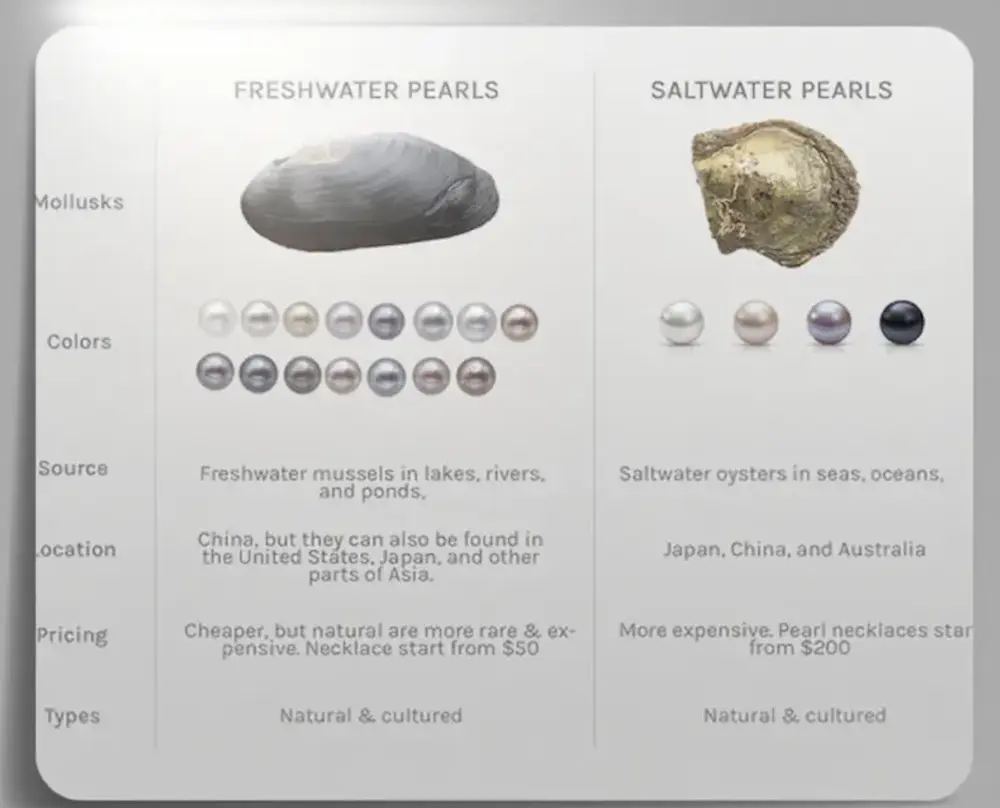
Freshwater Pearls Offer Incredible Variety
Shapes range across the spectrum:
- Round to near-round (most desirable for classic jewelry)
- Off-round and oval
- Button shapes (flat on one side)
- Baroque (wonderfully irregular, organic forms)
- Rice and potato shapes
Colors appear in an artist’s palette: white, cream, pink, peach, lavender, even metallic peacock tones. Many achieve these hues naturally, though some undergo treatment.
The luster of freshwater pearls tends toward a softer, inner glow—almost like candlelight rather than a spotlight. It’s beautiful, just different from the mirror shine of saltwater varieties.
Browse pearl strands and you’ll see how freshwater diversity creates unique design opportunities.
Saltwater Pearls Deliver Classic Elegance
The bead nuclei in saltwater cultured pearls help them grow rounder forms. This makes them perfect for matching strands where everything needs to be the same.
- Akoya pearls are white and cream with a dazzling, mirror-like shine that makes them stand out. Most people think of these when they think of “pearls.”
- Tahitian pearls offer exotic dark colors—black, silver, gray, green, even peacock with purple and blue overtones. They’re the only naturally dark pearls.
- South Sea pearls present white, silver, or luxurious golden hues. They’re the largest cultured pearls, often reaching 15-20mm.
7. Quality Factors: Evaluating Pearls Freshwater vs Cultured Saltwater
No matter what kind of pearl it is, six things affect its value:
- Luster is how light bounces off of the surface. Both types of high-quality pearls have great brilliance, however saltwater pearls usually have crisper reflections and freshwater pearls glow more gently.
- Surface Quality: The less flaws there are, the more valuable the item is. Freshwater and saltwater pearls can both have surfaces that are almost perfect, but saltwater pearls cost a lot more for perfection.
- Rounder pearls cost more in all categories. But more and more people like baroque shapes since they are unique and artistic.
- Size: The bigger it is, the more it costs. South Sea pearls are the biggest pearls in the world, and saltwater pearls tend to get bigger.
- Nacre thickness is important for both longevity and shine. Freshwater pearls are better because they are firm nacre. Quality saltwater pearls should have thick coatings of nacre over their bead cores.
- Matching: For strands, having the same size, shape, color, and shine greatly increases their value.
8. Making Your Decision: Which Type Suits You?
In the contrast of freshwater pearls and cultured saltwater pearls, there is no “winner.” Both have their own benefits.
When you want to buy cultured pearls, choose freshwater pearls.
- Want great value without giving up beauty
- Need pearls that will last for everyday wear
- Love different forms and colors
- Enjoy the soft, romantic shine
- Look for designs that are one of a kind and beautiful.
Pick saltwater cultured pearls when you:
- Want classic, vivid “pearl” style
- Want to invest -jewelry for grades
- Need spherical pearls that fit exactly
- I love both the classic white and the rare black kinds.
- Look for unusual, valuable diamonds
A lot of collectors and jewelry lovers have both kinds. They meet varied style needs and occasions.ns perfectly.
The Truth About Pearl Terminology
The jewelry industry hasn’t always used clear terminology when discussing pearls freshwater vs cultured varieties. Here’s what you might encounter:
Some traditional jewelers call freshwater pearls “cultured pearls” while referring to Akoya pearls as “real pearls” or simply “saltwater pearls.” This creates massive confusion because freshwater pearls are ALSO real pearls and also cultured.
Others might say “cultured pearls” without specifying type—they usually mean freshwater cultured pearls, since these are most common and affordable.
The best method to accomplish it is When you buy pearls, make sure to ask what kind they are: freshwater, Akoya, Tahitian, or South Sea. This clears up any confusion and makes sure you know exactly what you’re getting.
In the pearl business, we find it benefits everyone when we all use the right language, especially when discussing the difference between pearls freshwater vs cultured. Informed customers make smart purchases, trust builds between buyers and sellers, and ultimately, everyone wins.
FAQs
Are freshwater pearls considered real pearls?
Yes, freshwater pearls are real pearls. They grow in mussels in lakes and rivers.
Which is better, freshwater or cultured pearls?
This is a small trick. Freshwater pearls are a type of cultured pearl. “Cultured” just means they are grown on a pearl farm.
Why are freshwater pearls so much cheaper?
A freshwater mussel can make many pearls at one time (up to 50). A saltwater oyster usually makes only one or two. Because farmers can grow many more freshwater pearls, they cost less.
Which quality of pearl is best?
The best pearls are very shiny and reflect light (this is called luster). They are also very round and have a clean, smooth surface with no spots. This is often called “AAA” quality.
Final Thoughts: Embracing Pearl Diversity
It’s not a matter of which is better—freshwater-grown pearls or cultivated pearls. It’s about knowing your options when comparing pearls freshwater vs cultured in a market that is both attractive and diverse.
Freshwater farmed pearls have altered a lot in the last several decades. Pearls grown in fresh water using current methods are just as beautiful, glossy, and excellent as saltwater pearls. They are quite valuable, last a long time, and come in a wide range of styles.
Akoya, Tahitian, and South Sea saltwater cultivated pearls have the classic, high-end look that has been popular in jewelry for hundreds of years. Many consumers are willing to pay more for them because they are rare, come in different sizes, and have a beautiful shine.
Both types are actual pearls that were developed in real mollusks through diligent farming. Both should be appreciated for their beauty and unique traits.
When you’re ready to look at pearl jewelry, try to see different types in person if you can. Pay attention to how light moves over the varied surfaces of the pearls. Think about the style of luster you like best. Think about how you’ll really wear the things.
Keep in mind that the best pearl jewelry is what you love and will wear with delight and confidence for a long time. Regardless of the nuances of pearls freshwater vs cultured, you are choosing something truly lovely and timelessly attractive, whether it’s inexpensive freshwater pearls for everyday elegance or investment-grade saltwater pearls for special occasions.

